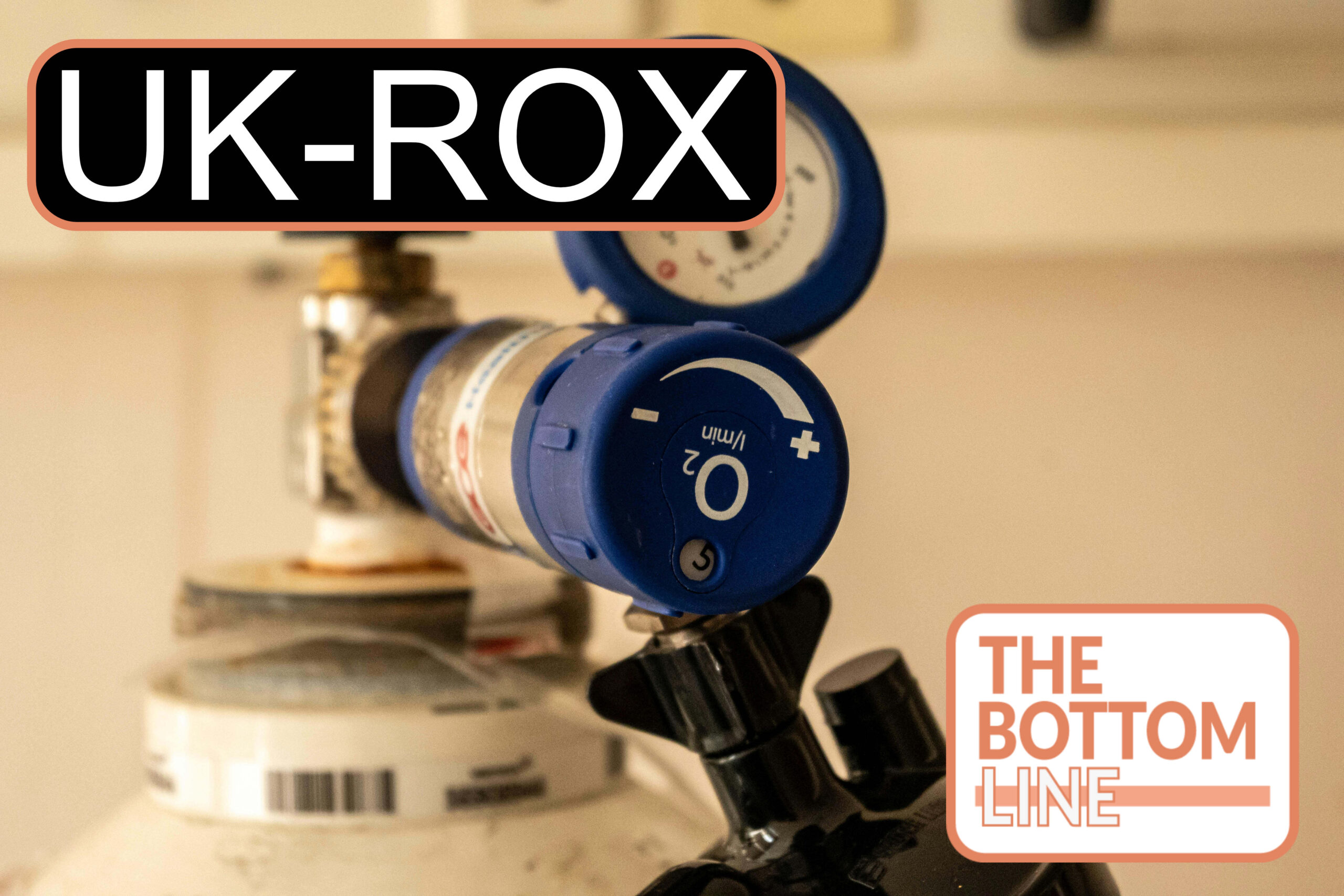UK-ROX Trial
Conservative Oxygen Therapy in Mechanically Ventilated Critically Ill Adult Patients
Martin. JAMA June 12 2025; doi:10.1001/jama.2025.9663
Clinical Question
- In mechanically ventilated adult patients in the ICU, does a strategy of conservative oxygen therapy, targeting a SpO2 of 90% (Range 88-92%) compared with usual care, reduce mortality at 90 days?
Background
- In the United Kingdom, around 184,000 adults are admitted to an intensive care unit (ICU) each year, with over 30% receiving mechanical ventilation. Oxygen is the commonest therapeutic intervention provided to these patients but it is unclear how much oxygen should be administered for the best clinical outcomes
- There are a number of trials that have been conducted (for example the OXYGEN trial, HOT-ICU, ICU-ROX, PILOT trial) or are ongoing (MEGA-ROX) that have aimed to find the optimal SpO2 target in critically ill patients, however, there are inconsistencies in trial design, heterogeneity in patients included and varying comparators, so conclusions are difficult to draw.
- A recent meta-analysis of 13 trials with more than 10000 patients reported no difference in mortality between a liberal and conservative strategy.
Design
- Pragmatic, registry-embedded RCT
- Intubated patients in the ICU were randomised 1:1 to receive conservative or usual O2 therapy until ICU discharge or 90 days after randomisation
- Randomisation occurred as soon as possible after eligibility met
- Allocation concealment occurred by web randomisation which determined the treatment arm
- The allocation was not blinded
- Randomisation used permuted blocks with variable block sizes, stratified to site and diagnosis
- A sample size of 16 500 provided 90% power at P < .05 to detect an absolute risk reduction of 2.5%, from 37% to 34.5% with conservative oxygen therapy, assuming a 6% loss to follow-up
- Diagnostic subgroups were identified: hypoxic-ischemic encephalopathy, sepsis, other acute brain injury
Setting
- 97 NHS ICUs in England, Wales and Northern Ireland
- The trial recruited patients from May 2021 to Nov 2024
Population
- Inclusion:
- ≥ 18 years
- Within 12 hours of receiving invasive mechanical ventilation (IMV) following an unplanned admission to ICU or IMV started in the ICU, and a FiO2> 21%
- Exclusion: Previously randomised to UK-ROX, receiving ECMO, clinician considered one of the treatment arms was contraindicated
- 16500 patients were randomised: 8258 to conservative oxygen therapy, 8242 to usual oxygen therapy. Some patients requested removal of data (consent was not required before randomisation), leaving the primary outcome available in 8230 in the conservative oxygen group and 8204 in the usual oxygen group
- Of the 49,233 who met inclusion criteria:
- 21,979 were eligible but not randomised (14,865 missed / identified too late)
- 10,754 met exclusion criteria (10,582 was clinician deeming one arm contraindicated)
- Of the 49,233 who met inclusion criteria:
- Baseline characteristics were well matched between the groups:
- Median age was 60 and 61.8% were male
- Approximately 33% had sepsis, 9% HIE, COVID-19 6.7%.
- Median FiO2 was 0.45
- APACHE II score 16
Intervention
- Conservative oxygen
- Participants in the conservative oxygen group received the lowest FiO2 to maintain SpO2 at 90% (monitor alarms were set to alarm if SpO2 < 88% or >92% – until the patient was receiving FiO2 21%)
- Deviations were allowed if there was a major discrepancy in ABG derived SaO2 or if a life-threatening event necessitated higher SpO2
- Participants in the conservative oxygen group received the lowest FiO2 to maintain SpO2 at 90% (monitor alarms were set to alarm if SpO2 < 88% or >92% – until the patient was receiving FiO2 21%)
Control
- Standard care
- Participants received oxygen at the discretion of the treating clinician, with no minimum FiO2 mandated, and no SpO2 upper limit defined
Management common to both groups
- Other therapies were at the discretion of the treating teams
Outcome
- Primary outcome:
- All-cause mortality at day 90 after randomisation
- 2908 (35.4%) died in the conservative group vs 2858 (34.9%) in the usual O2 group
- After adjustment for pre-specified baseline variables, the risk difference was 0.7% (95% CI, -0.6 to 2.1, p = 0.28)
- Secondary outcomes: No difference in:
- Duration of ICU stay
- Duration of acute hospital stay
- Days alive and free from organ support (at Day 30)
- Mortality at ICU and hospital discharge
- Mortality at 1-year (at the time of publishing, not all patients had reached the 1-year follow-up)
- There were no differences in the primary outcome when the diagnostic subgroups outlined above were considered
- Enhanced data collection occurred in 2500 patients: the first patients at each site were included in this more intense data collection and then patients randomly throughout the trial. This data looked more closely at adherence to the trial procedures and EQ-5D-5L at 90 days.
- 526 (42.1%) had a period of non-adherence equating to ~10% of their ICU time
- There was separation in FiO2 and SpO2 between the groups and the cumulative exposure to supplemental oxygen was lower in the conservative group suggesting good overall adherence to the prescribed therapy
- Mean of the median SpO2 in conservative group 93.3% vs 95.1%
- Conservative group spent a mean of 62.6 hours with SpO2 88-92% compared to 27.2 in usual oxygen therapy group
Authors’ Conclusions
- In mechanically ventilated adult patients admitted to ICU, a conservative strategy of oxygen exposure targeting a SpO2 of 90% did not reduce all-cause mortality at 90 days compared with usual oxygen therapy.
Strengths
- This is the largest trial conducted in mechanically ventilated ICU patients exploring this question of conservative vs usual oxygen therapy ensuring adequate power to detect a clinically meaningful outcome
- Given oxygen is ubiquitously administered in ICU patients, there is little known about the optimal dose and so this trial asks a very important clinical question
- The trial has good internal validity: allocation concealment, intention-to-treat analysis and near complete follow-up
- The primary outcome was clinically meaningful
- There was a separation in the groups as far as therapies received
- The results are likely generalisable to ICUs outside of the UK
Weaknesses
- Clinicians were unblinded to treatment allocation, however the outcome of mortality is unlikely to be impacted by this
- Oxygen exposure prior to intubation and prior to randomisation was not accounted for and may influence outcomes in this critically ill population
- The power calculation aimed to detect a difference of 2.5% in the primary outcome. It is possible a smaller difference in mortality may be detectable with a larger sample size. This difference may be small but potentially clinically important
The Bottom Line
- My ICU is currently enrolling patients in the MEGA-ROX study which aims to recruit 40000 mechanically ventilated patients to a strategy of conservative or liberal oxygen therapy
- UK-ROX adds significantly to the growing data to guide optimal oxygen targets in Invasive Mechanically Ventilated patients in the ICU
- The pooled results of both those studies will help guide clinicians to optimise oxygen prescription in the ICU
External Links
- article The UK-ROX trial
- further reading MEGA-ROX
Metadata
Summary author: Celia Bradford – @celiabradford
Summary date: June 22 2025
Peer-review editor: George Walker
Picture by: V Srajber / Pexels




